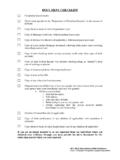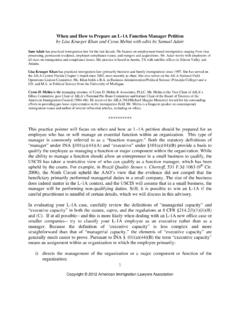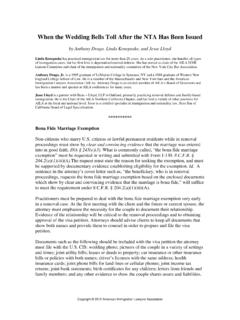Transcription of Virtue--Dealing with Unlawful Presence
1 Copyright 2012 American Immigration Lawyers Association Dealing with the Unlawful Presence Bars by Paul Virtue, Michael Davis, and Kelli Stump Paul W. Virtue is a Partner in the Global Immigration and Migration Practice of Baker & McKenzie, LLP. He is a member of the Nominating Committee of the AILA Washington, DC Chapter. Michael H. Davis is Managing Partner at Davis & Goldfarb in Minneapolis, MN. He is co-Chair of AILA s DHS International Operations Liaison Committee and co-Editor of AILA s The Consular Practice Handbook. Kelli J. Stump is a senior associate at Stump & Associates in Oklahoma City, OK. She serves on the AILA ICE Liaison Committee, AILA Membership Committee, and she is Secretary of the AILA Texas/Oklahoma/New Mexico Chapter. Every application for a legal permanent residence or an immigrant visa requires in-depth knowledge and understanding of the inadmissibility bars under sections 212(a)(9)(B) and 212(a)(9)(C).
2 This practice pointer is intended to assist the immigration practitioners with understanding the effect of the Ninth Circuit s recent decision in Carrillo de Palacios v. Holder and INA 245(i) on the bars. The Illegal Immigration Reform and Immigrant Responsibility Act of 1996 (IIRIRA) created new statutory grounds for the exclusion of aliens unlawfully present in the United As of April 1, 1997, aliens unlawfully present in the United States for more than 180 days, but less than one year, who voluntarily depart the United States, are inadmissible for three Aliens unlawfully present in the United States for more than one year, who voluntarily depart or are removed, are inadmissible for ten INA 212(a)(9)(C) provides a permanent bar to admission for aliens who have accrued an aggregate period of Unlawful Presence , or have been ordered removed and have entered or attempted to reenter the United States at any time.
3 An exception exists for aliens granted advance permission to reenter more than ten years following the last departure from the United States4 and a waiver for Violence Against Women Act 5 self-petitioners who can demonstrate a connection between the battering or cruelty and their removal, departure from the United States, attempted reentries or reentries into the United INA 212(a)(9)(B)(iii) provides for certain exceptions to the timeframe that would otherwise be counted toward the accrual of Unlawful Presence , including: time spent in the United States when the alien is 18 years of age or younger; time when a bona fide asylum application is pending, unless the individual engages in unauthorized employment; time when the alien is a beneficiary of family unity protection under Section 301 of the Immigration Act of 1990; and time spent in violation of nonimmigrant status by battered woman and children, provided the alien can demonstrate a substantial connection between the battery and the Unlawful Presence .
4 1 Division C of the Omnibus Appropriations Act of 1996 ( 3610), Pub. L. No. 104-208, 110 Stat. 3009. 2 INA 212(a)(9)(B)(i)(I). 3 INA 212(a)(9)(B)(i)(II). 4 INA 212(a)(9)(C)(ii). 5 INA 204(a)(1)(A)(iii)-(v); 204(a)(1)(B)(ii)-(iv). 6 INA 212(a)(9)(C)(iii). Copyright 2012 American Immigration Lawyers Association Effect of Recent 9th Circuit Decision (Carrillo de Palacios) On June 21, 2011, the Ninth Circuit issued its decision in Carrillo de Palacios v. Holder,7 essentially changing everything practitioners know regarding Unlawful Presence and INA 212(a)(9)(C)(i)(I). Previously, practitioners understood that since the effective date of INA 212(a)(9)(B) was April 1, 1997, aliens did not accrue Unlawful Presence until that date, and thus those aliens would not be subject to the three and ten year bars until September 1997 (180 days after April 1) and April 1, 1998 (one year after April 1, 1997).
5 Likewise, an individual who had accrued more than one year of Unlawful Presence prior to April 1, 1998 and departed prior to April 1, 1998 but returned without being admitted would not be inadmissible under INA 212(a)(9)(C)(i)(I). In Carrillo de Palacios, the Ninth changed the landscape, holding that an alien who accrued more than one year of Unlawful Presence prior to April 1, 1997* and who departed prior to April 1, 1997 but reentered EWI after April 1, 1997 is inadmissible under 212(a)(9)(C)(i)(I). The court held that [t]he statutory text is straightforward: an alien is inadmissible if she has been unlawfully present in the United States for an aggregate period of more than 1 year and subsequently enters the United States without being admitted. 8 The Petitioner argued that such analysis impermissibly applied the statute retroactively. The court disagreed, however, finding that the conduct the statute addresses is not the actual Unlawful Presence , but the Unlawful entry after April 1, 1997.
6 The court determined that under the statute, it is the alien's present or future reentry that triggers [212](a)(9)(C)(i)(I), not her past Unlawful Presence , 9 and [a] law that applies to conduct occurring after the effective date of the new law may look[ ] back to a past act without being impermissibly On December 1, 2011, the Ninth withdrew its opinion and reissued a new In its new opinion, the court removed the language permitting the accrual of pre-IIRIRA Unlawful Presence under INA 212(a)(9)(C)(i)(I), and denied relief under INA 212(a)(9)(C)(i)(II). The court declined to address the BIA s analysis of Unlawful Presence pre April 1997. Thus remains the issue regarding the BIA s new analysis of Unlawful Presence pre-IIRIRA. Those practitioners with clients who accrued Unlawful Presence before IIRIRA and reentered without being admitted post IIRIRA should be cautioned.
7 Does 245(i) Help? It is important to remember that the three and ten year bars under INA 212(a)(9)(B) are only triggered upon departure of the alien from the United States. What if the alien can adjust status in the United States, thus not having to depart? 7 651 969 (9th Cir. 2011). 8 Id. At 973. 9 Id. At 977 10 Id. At 976 (citing Fernandez-Vargas v. Gonzales, 548 30, 44 (2006). 11 Carrillo de Palacios v. Holder, 662 1128 (9th Cir. 2011). Copyright 2012 American Immigration Lawyers Association In December 2000, Congress enacted the Legal Immigration Family Equity Act (LIFE Act). The LIFE Act amended 245(i) (8 1255) to allow certain individuals who are ineligible for adjustment in the United States because they entered without inspection (EWI) or otherwise violated their immigration status to seek adjustment nonetheless, if they pay a $1000 penalty.)
8 Moreover, to be eligible for adjustment pursuant to 245(i), the individual must be a beneficiary of an immigrant visa petition filed before April 30, 2001. Specifically, the provision states: (1) Notwithstanding the provisions of subsections (a) and (c) of this section, an alien physically present in the United States (A) who (i) entered the United States without inspection; or (ii) is within one of the classes enumerated in subsection (c) of this section; (B) who is the beneficiary (including the spouse or child of the principal alien, if eligible to receive a visa under section 203(d) [8 1153 (d)] of (i) a petition for classification under section 204 [8 1154] that was filed with the Attorney General on or before April 30, 2001; or (ii) an application for labor certification under section 212(a)(5)(A) [8 1182(a)(5)(A)] that was filed pursuant to the regulations of the Secretary of Labor on or before such date.)
9 And (C) who, in the case of a beneficiary of a petition for classification, or an application for labor certification, described in subparagraph (B) that was filed after January 14, 1998, is physically present in the United States on the date of the enactment of the LIFE Act Amendments of 2000 [December 21, 2000]; may apply to the Attorney General for the adjustment of his or her status to that of an alien lawfully admitted for permanent residence. The attorney General may accept such application only if the alien remits with such application a fee of $1000 as of the date of receipt of the application ..12 But, can 245(i) help if an alien accrued Unlawful Presence , departed, and reentered the United States without inspection? Under new law, the answer is likely no. In 2005 and 2006, the Ninth and Tenth Circuits were holding that 245(i) trumped 212(a)(9)(C)(i)(I).
10 13 In 2007, the BIA issued its decision in Matter of Briones,14 holding that an alien who was inadmissible under INA 212(a)(9)(C)(i)(I) is ineligible for adjustment of status under 245(i). The Tenth Circuit has now held that that the BIA s determination in Matter of Briones, was a reasonable interpretation of ambiguous statutory provisions to which the court owed Chevron Can Time Spent in the Count Towards Satisfying the INA 212(a)(9)(B)(i) and/or 212(a)(9)(C) Unlawful Presence Bars? 12 INA 245(i) 13 See Acosta v. Gonzales, 439 1158(9th Cir. 2006), Padilla-Caldera v. Gonzales, 426 1294 amended on reh g by 453 1237 (10th Cir. 2006). 14 24 I&N Dec. 355 (BIA 2007) 15 Padilla-Caldera v. Holder, 673 1140 (10th Cir. 2011). Copyright 2012 American Immigration Lawyers Association Since the INA 212(a)(9)(B) effective date was April 1, 1997, persons unlawfully present in the first became subject to the 3-year bar in late September 1997 (180 days after April 1) and to the 10-year bar on April 1, 1998.









